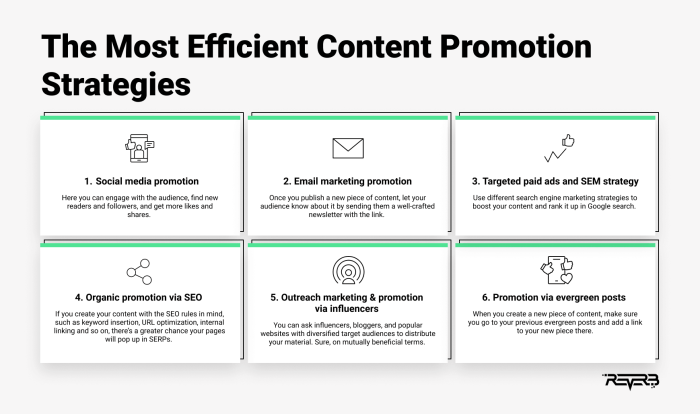Content Promotion Best Practices dives into the art of reaching a wider audience through effective strategies and engaging content creation. From social media to , this guide covers it all with a cool high school vibe that will keep you hooked.
Importance of Content Promotion: Content Promotion Best Practices
Yo, let me break it down for ya – content promotion ain’t just an extra step in the game, it’s the key to getting your message out there to a bigger crowd. Without promotion, your dope content might as well be hidden in the shadows, know what I’m sayin’?
Reaching a Wider Audience
When you promote your content like a boss across different channels, you’re casting a wider net and pulling in a larger audience. More eyes on your content means more chances to connect with peeps who vibe with your message.
Benefits of Content Promotion
- Grows Your Brand: Effective content promotion helps build brand awareness and loyalty among your peeps. It’s like putting your name out there for everyone to see.
- Increases Engagement: When you promote your content right, you’re sparking conversations, getting peeps to engage with your brand, and building a community of loyal fans.
- Boosts Conversions: Promoting your content smartly can lead to more peeps taking action, whether it’s signing up, making a purchase, or spreading the word about your brand.
Successful Content Promotion Strategies by Leading Brands
Check out how the big players in the game are slaying the content promotion game:
-
Social Media Domination: Brands like Nike and Starbucks kill it on social media by creating engaging content and connecting with their audience on platforms like Instagram, Twitter, and Facebook.
-
Influencer Collaborations: Companies like Glossier and Gymshark team up with influencers to promote their content to a wider audience and tap into their followers for major impact.
-
Magic: Brands like HubSpot and Moz use killer strategies to boost their content visibility and attract organic traffic to their sites like bees to honey.
Types of Content Promotion Channels

Promoting content through various channels is crucial for reaching a wider audience and increasing engagement. Let’s explore the different types of content promotion channels and their advantages and disadvantages to help you choose the right mix for your target audience and content type.
Social Media
- Social media platforms like Facebook, Instagram, Twitter, and LinkedIn are great for reaching a large audience quickly.
- Advantages: Instant feedback, viral potential, and the ability to target specific demographics.
- Disadvantages: High competition, short content lifespan, and algorithm changes affecting reach.
Email Marketing
- Email marketing allows for direct communication with your audience through personalized messages.
- Advantages: High conversion rates, targeted messaging, and the ability to segment your audience.
- Disadvantages: Risk of being marked as spam, low open rates, and potential for unsubscribes.
Influencer Partnerships
- Collaborating with influencers can help you reach a new audience and build credibility.
- Advantages: Authentic endorsements, access to a loyal following, and potential for viral content.
- Disadvantages: Costly partnerships, lack of control over the influencer’s content, and potential backlash from their audience.
Content Promotion Strategies

Creating engaging content that is shareable and promotable is essential for successful content promotion. To achieve this, it is important to focus on providing value to your audience, understanding their needs and preferences, and incorporating elements that encourage sharing and engagement.
Role of in Content Promotion
Search Engine Optimization () plays a crucial role in content promotion by helping your content rank higher in search engine results pages (SERPs). To optimize content for search engines, it is important to conduct research, optimize meta tags and descriptions, create high-quality content, and build backlinks from reputable websites.
- Conduct research to identify relevant and high-ranking s for your content.
- Optimize meta tags, including title tags and meta descriptions, to improve visibility in search results.
- Create high-quality, informative, and engaging content that provides value to your audience.
- Build backlinks from authoritative websites to improve your content’s credibility and visibility.
Optimizing content for search engines can help increase organic traffic and visibility, leading to higher engagement and conversions.
Utilizing Paid Promotions Effectively
Paid promotions can be a powerful tool to boost content visibility and reach a larger audience. When using paid promotions, it is important to target your audience effectively, choose the right platform for promotion, set clear objectives, and monitor and adjust your campaigns for optimal results.
- Target your audience based on demographics, interests, and behavior to reach the right people with your content.
- Choose the right platform for promotion based on where your target audience is most active, whether it’s social media, search engines, or other channels.
- Set clear objectives for your paid promotions, whether it’s increasing brand awareness, driving website traffic, or generating leads.
- Monitor the performance of your paid promotions regularly and make adjustments to optimize your campaigns for better results.
Measuring Content Promotion Success
When evaluating the success of content promotion campaigns, it is essential to track key metrics that provide insights into the effectiveness of your efforts. By measuring specific data points, you can make informed decisions to optimize future strategies.
Key Metrics to Track
- Website Traffic: Measure the increase in website visits resulting from your content promotion activities.
- Conversion Rates: Track how many visitors take the desired action, such as signing up for a newsletter or making a purchase.
- Social Engagement: Monitor likes, shares, comments, and other interactions on social media platforms to gauge audience engagement.
- Click-Through Rate (CTR): Measure the percentage of people who clicked on your content compared to the total number of impressions.
Tools and Analytics Platforms, Content Promotion Best Practices
Utilizing tools and analytics platforms can help you measure the effectiveness of your content promotion efforts by providing detailed insights and data analysis. Some popular tools include:
- Google Analytics: Offers a wide range of metrics to track website performance and user behavior.
- Buffer: Allows you to schedule and analyze social media posts to optimize engagement.
- HubSpot: Provides tools for tracking leads, conversions, and overall marketing performance.
Data-Driven Insights in Action
Here are some examples of how data-driven insights can inform future content promotion strategies:
By analyzing CTR data, a company discovered that their email marketing campaigns were more effective in driving conversions compared to social media promotions. They decided to reallocate their resources towards email campaigns to maximize ROI.
Through website traffic analysis, a business identified that a particular blog post was generating the most leads. They used this insight to create similar content and boost their lead generation efforts.





